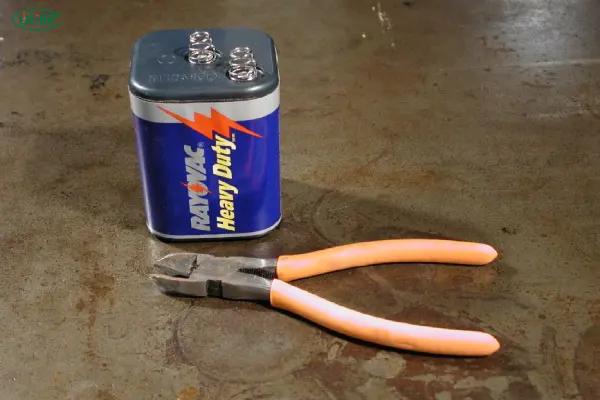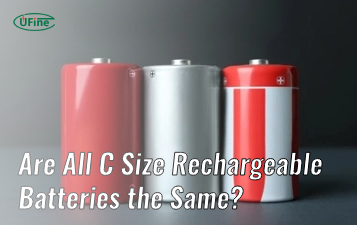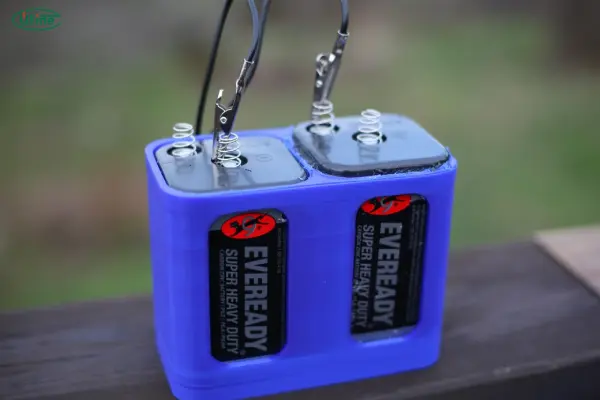
- Part 1. Chemistry: What’s inside a lantern battery?
- Part 2. Lantern battery size
- Part 3. Voltage: why It matters
- Part 4. Rechargeable vs. disposable lantern batteries
- Part 5. Explore custom lantern battery solutions with Ufine Battery
- Part 6. How long can a lantern battery last?
- Part 7. What affects the life of a lantern battery?
- Part 8. Signs that a lantern battery needs to be replaced
- Part 9. Final thoughts
- Part 10. FAQs
You’ve probably seen a lantern battery before—those large, blocky batteries often used in flashlights, emergency lights, or camping lanterns. But what exactly is a lantern battery?
Simply put, a lantern battery is a high-capacity battery designed to provide long-lasting power to portable lanterns or large flashlights. Unlike the common AA or AAA batteries, lantern batteries are big, tough, and made to last for hours or even days. They’re usually used in situations where steady light is critical—like during power outages, camping trips, or industrial work.
Let’s explore what makes these batteries so special, how they’re made, and how to choose the right one.
Part 1. Chemistry: What’s inside a lantern battery?
Just like people, not all batteries are the same on the inside. Lantern batteries can use different battery chemistries, and each has its own strengths.
Common Lantern Battery Chemistries:
- Zinc-Carbon: These are affordable and easy to find. They’re ideal for low-drain applications. However, they don’t last very long.
- Alkaline: A step up in power and shelf life. Alkaline lantern batteries are great for emergency lanterns and more frequent use.
- Lithium: High energy density, lightweight, and excellent performance in extreme temperatures. Great for long-term outdoor use.
- Lead-Acid (Sealed or Gel): Found in rechargeable lanterns. They’re heavier but provide strong and consistent power. Ideal for professional or rugged use.
- NiMH (Nickel Metal Hydride): Rechargeable and eco-friendly. A good choice for users who prefer a sustainable option.
Alkaline vs. Carbon-Zinc vs. Lithium Batteries: A Complete Guide
Each chemistry type affects the cost, performance, and longevity of your lantern battery. So choosing the right one really depends on your needs.
Part 2. Lantern battery size
Lantern batteries are bigger than standard household batteries. The most common size is the 6V lantern battery, which looks like a big rectangular block with spring terminals on top.
There are also 4.5V and 12V lantern batteries, though they’re less common and often used in more specialized equipment.
Standard Lantern Battery Sizes:
Battery Voltage Common Use Case 4.5V Smaller lanterns and toys 6V Flashlights, camping lanterns 12V Heavy-duty or industrial lights
These sizes are not interchangeable, so always check your device’s manual before buying a new lantern battery.
Part 3. Voltage: why It matters
Voltage tells you how much electric pressure the battery can supply. Most lanterns are designed for a specific voltage—often 6 volts.
- A 6V lantern battery can run a standard incandescent or LED lantern for many hours.
- A 12V lantern battery is often used in brighter, more powerful lanterns, especially for outdoor use or emergencies.
Using a battery with the wrong voltage could damage your lantern—or simply not work at all. So again, make sure to match the battery to your device.
Part 4. Rechargeable vs. disposable lantern batteries
Let’s break this down in a detailed comparison. Should you go with a rechargeable or a disposable lantern battery?
| Feature | Rechargeable | Disposable |
|---|---|---|
| Initial Cost | Higher | Lower |
| Long-Term Cost | Lower (reusable) | Higher (keep buying new ones) |
| Eco-Friendly | ✅ Yes | ❌ No |
| Shelf Life | Shorter (self-discharges) | Longer (ideal for emergencies) |
| Maintenance | Needs charging | No maintenance |
| Power Output | Stable over time | Decreases as it drains |
When to choose rechargeable:
- You use your lantern regularly (e.g., for work, camping).
- You want to reduce waste and save money long term.
When to choose disposable:
- You want a long shelf-life (e.g., emergency kits).
- You don’t want to worry about recharging.
Pro tip: Some modern lanterns now support USB-rechargeable lithium battery packs. These are ultra-convenient and compatible with solar panels or power banks.
Part 5. Explore custom lantern battery solutions with Ufine Battery
Ufine Battery, a professional lithium battery manufacturer from China, offers:
- Custom Li-ion, LiFePO4, and Li-Polymer batteries
- Cylindrical, ultra-thin, high-rate, and high-temperature battery designs
- Support for varied voltages, capacities, and sizes for lanterns, emergency devices, and more
Whether you’re building a new product or upgrading your existing lantern system, Ufine can help you power it efficiently.
Contact Ufine Battery today to discuss your custom lantern battery needs and get a free consultation.
Part 6. How long can a lantern battery last?
Battery life depends on several things—mainly the type of battery, how bright the lantern is, and how often you use it.
Here are general estimates for how long different types of lantern batteries last:
| Battery Type | Light Setting | Estimated Run Time |
|---|---|---|
| 6V Zinc-Carbon | Medium | 8–10 hours |
| 6V Alkaline | Medium | 15–20 hours |
| 6V Lithium | Medium | 25–35 hours |
| Rechargeable NiMH | High | 5–10 hours per charge |
| Lead-Acid 6V | High | 10–15 hours per charge |
Brightness settings matter! Lower light modes can double or even triple battery life.
Part 7. What affects the life of a lantern battery?
Several factors influence how long your lantern battery lasts—some you can control, and some you can’t:
- Battery Chemistry: Lithium batteries generally last longer than zinc-carbon or alkaline.
- Usage: Using the highest brightness setting all the time will drain the battery quickly.
- Temperature: Cold weather can reduce battery performance, especially for alkaline types.
- Storage: Batteries lose charge over time if not stored properly. Humid environments can also cause corrosion.
- Battery Quality: Cheaper brands often don’t perform as well or last as long.
Tip: Store batteries in a cool, dry place, and check them every 6 months if unused.
Part 8. Signs that a lantern battery needs to be replaced

It’s not always obvious when a battery is about to die. Here are common signs:
- Dim or flickering light
- Lantern turns off suddenly
- Charging takes longer than usual (for rechargeables)
- Corrosion or leakage around the terminals
- Strange smell or bulging battery casing
If you notice any of these, it’s best to replace the battery right away to avoid damage to your lantern—or being left in the dark when you need it most.
Part 9. Final thoughts
A lantern battery may seem simple, but it plays a crucial role in your lighting setup—whether you’re out in nature or dealing with a blackout. From chemistry to voltage, and from rechargeable to disposable, choosing the right battery can make a big difference in performance and safety.
Remember to think about your specific needs:
- Daily use? Go rechargeable.
- Emergency backup? Keep a fresh alkaline battery nearby.
- Cold environments? Go for lithium.
Want a custom lantern battery designed exactly for your device? Looking for high-capacity, temperature-resistant, or ultra-light batteries?
Part 10. FAQs
Can I use a 6V lantern battery in a 4.5V lantern?
No. Using a battery with higher voltage than recommended can damage the lantern or shorten its life.
Are lantern batteries waterproof?
Most lantern batteries are not waterproof. If you use your lantern outdoors, make sure both the lantern and battery compartment are sealed.
How should I dispose of an old lantern battery?
Follow your local recycling guidelines. Never throw batteries in the trash, especially lithium or lead-acid types.
Can I recharge a disposable lantern battery?
No. Attempting to recharge a disposable battery is dangerous and could lead to leakage or explosion.
What is the best lantern battery for camping?
For long trips, alkaline or lithium lantern batteries are great because of their long run times and durability in different weather conditions.
Related Tags:
More Articles

Are All C Size Rechargeable Batteries the Same?
Compare rechargeable C cell batteries by type, voltage, capacity, and lifespan. Find the best C batteries for toys, flashlights, and emergency devices.
Learn how to safely recharge 18650 batteries, choose the best 18650 battery charger, and extend battery life with expert tips and practical strategies.
12 Volt Batteries: How Long Can They Really Last?
Discover the real lifespan of 12V batteries. Compare lead-acid, AGM, gel, and lithium (LiFePO₄) batteries — and find out why LiFePO₄ lasts over 10 years.
Lithium-ion vs Lithium Polymer Battery: Which is Better?
Compare Li-ion and LiPo batteries in energy, safety, lifespan, and uses. Learn which battery is best for drones, laptops, and wearables.
Power Pack Battery vs. Power Bank: What’s the Difference?
Compare power pack battery and power bank: capacity, devices, portability, and best uses to pick the right portable battery pack.



